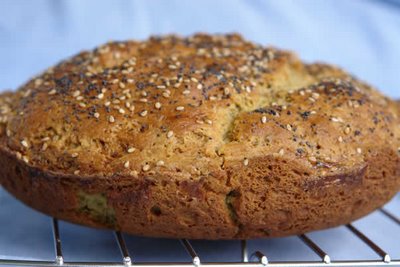Homemade Gluten-Free Pulled-Chicken / Pulled-Pork Recipe
My wife created this gluten-free treat for me: her own recipe for fantastic pulled-chicken (or pork), from scratch, that is just wonderful and full of flavor imparted from the peppery and smokey combination of poblano and acho peppers, and even some gluten-free beer! I find it quite excellent served alone as a main course, or served on corn tortillas with avocado, tomato, sour cream, salsa, shredded lettuce, etc. - for a SouthWestern style treat (a great way to serve any leftovers). |
| Homemade Barbecue Pulled-Chicken |
The Recipe
I placed the recipe inline (below), or you can also get it from our cookbook website recipe library here: homemade gluten-free pulled-chicken / pulled-pork recipe; substituting a pork roast for the chicken is quite simple.Pulled-Chicken Ingredients:
2 Tablespoons Olive Oil4 Chicken Breasts (boneless/skinless)
6 Chicken Thighs (skin & fat removed)
½ Tablespoon Ancho Chile Pepper Powder (increase to ¾ tablespoon for really spicy sauce)
½ Teaspoon Black Pepper
1 Teaspoon Garlic Powder
½ Cup Buffalo Wing Sauce*
1¼ Cup Vegetable Broth*
½ Cup Sorghum Beer
5 Garlic Cloves (remove paper skin but leave whole)
1 Medium Onion (quartered)
1 Poblano Pepper (whole)
*Note – used:
- ½ Cup Anchor Bar (Frank & Teressa’s) – Buffalo Wing Sauce / Hotter Recipe. Label on bottle states gluten free.
- 1¼ Cups Kitchen Basics Natural Vegetable Cooking Stock. Label on container stated gluten free.
Homemade Honey BBQ Sauce Ingredients:
3 Tablespoons Tomato Paste4 Tablespoons Honey
2 Tablespoons Sugar
1 Tablespoon Molasses
1 Tablespoon Apple Cider Vinegar
½ Cup Water
½ Teaspoon Ground Mustard
1 Teaspoon Garlic Powder
½ Teaspoon Onion Powder
¼ Teaspoon Black Pepper
½ Teaspoon Cayenne Pepper (increase to 1 teaspoon for really spicy sauce)
½ Teaspoon Chili Powder (increase to 1 teaspoon for really spicy sauce)
Directions:
Preheat oven to 325°.Create Honey BBQ sauce by placing all ingredients in a large bowl and mixing together.
Prepare chicken by removing skin and any excess fat. In a large cast iron Dutch oven (or other large stovetop and oven-safe pot with lid), heat oil on stove-top. Place chicken in bottom of pot. Sprinkle ancho Chile pepper powder, black pepper and garlic powder over exposed chicken. Allow chicken to brown on one side (takes a few minutes); flip chicken and repeat, allowing other side of chicken to brown. Add remaining ingredients, including the Honey BBQ sauce you created, and stir.
Place lid over pot and carefully move to oven (pot is extremely hot). Allow to cook until chicken is tender and falls off the bone, approximately 2½ hours.
Remove from oven. The chicken should look like this:
 |
| Cooked Chicken, spicy and ready to be shredded. |
Discard the onion, poblano pepper and garlic. Remove chicken pieces from pot (reserve juices) and shred using two forks; discard bones. Place shredded chicken in serving bowl and cover with reserved juices; serve.
Your end product, the pulled-meat dish, should look something like this:
 |
| Homemade Barbecue Pulled-Chicken |
Continue to read this Gluten-Free Blog for all sorts of gluten-free recipes, product-reviews, and related information. In addition, visit my Gluten-Free Recipes Site where many of the recipes I have featured on this blog are available.




